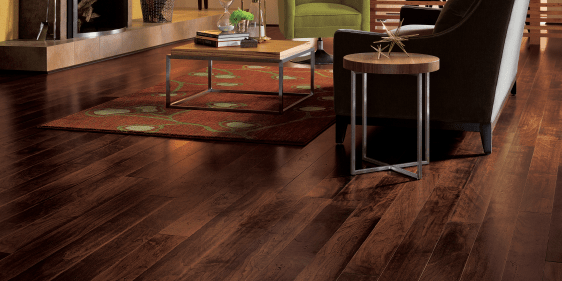Solid Hardwood Flooring vs. Engineered vs. Laminate

Hardwood flooring’s hardwood flooring, right? Take a tree, cut it down, put some varnish on and put it on the floor. Isn’t that how it works? Maybe once upon a time. But when you go shopping for hardwood floors, you may find yourself bewildered by all the different types of flooring available. There’s solid hardwood floors, engineered hardwood floors, laminate floors. Is it all real wood? What’s going to work best for your home? Relax, we’ve got answers.
Maybe once upon a time. But when you go shopping for hardwood floors, you may find yourself bewildered by all the different types of flooring available. There’s solid hardwood floors, engineered hardwood floors, laminate floors. Is it all real wood? What’s going to work best for your home? Relax, we’ve got answers.
But when you go shopping for hardwood floors, you may find yourself bewildered by all the different types of flooring available. There’s solid hardwood floors, engineered hardwood floors, laminate floors. Is it all real wood? What’s going to work best for your home? Relax, we’ve got answers.
Solid Hardwood Flooring
Solid hardwood is exactly that —a tree simply cut into planks, treated, stained, coated and put on your floor. This is the typical type many people think of when they think of hardwood flooring. It is durable, long-lasting and can usually be sanded and refinished more than one time.
However, solid hardwood is generally not installed over concrete slab floors and is usually nailed down into plywood subfloors. Unlike engineered hardwood, solids typically are not floated over existing flooring or glued down if needed. This leads to generally higher labor costs and more floor prep with solid hardwood, removing the existing flooring and getting your subfloor ready.
However, for those seeking a classic product and who have the proper surface for installation, solid hardwood flooring will always be a safe bet. There’s just something rich and magical about traditional hardwood floors.
Engineered Hardwood Flooring
Don’t let the name fool you – engineered hardwood floors are still real wood. This isn’t something made in a lab; it comes from real trees and everything.
What makes engineered hardwood different is the way it is prepared. Layers of wood are compressed together to create a product with special advantages. Each layer runs counter to the layer below it and this creates “dimensional stability.” This stability means that your new flooring is less likely to distort when exposed to changes in moisture and temperature, the two primary external causes of failure in hardwood flooring applications.
Engineered hardwood flooring can be installed below, on, or above grade and over a variety of surfaces, including existing vinyl or tile floors in many instances. This can greatly reduce your labor costs. It also tends to be less expensive than its solid cousin, which is always a good thing.
Laminate Flooring
Laminate flooring is a modern marvel! You wouldn’t be able to buess just by looking at it, but laminate floors don’t have a scrap of wood in them. And now it comes in tile and stone looks as well. An image of the wood, tile or stone is printed on a hard core, giving it the same look of natural wood or tile, in any color imaginable – and even a few not found in nature.
It has some distinct advantages, including its durability and resistance to scratching. If you have children or pets, laminate flooring can give your home the rich look of hardwood but holds up much better against scrapes from toys and shoes or clumsy claws scratching the surface. Laminate is perfect for a busy and bustling household.
However, be careful with water as laminate is not as forgiving with moisture as engineered or even solid hardwood. Excessive exposure to moisture can cause air pockets and warping. So, make sure you keep it in a relatively dry place and never mop your laminate.
What Do Most People Prefer?
In the flooring industry, we’ve seen a big shift toward engineered hardwood over the past ten years. Engineered hardwood is essentially indistinguishable from solid, yet it usually offers similar finish warrantees, performance characteristics and often lower out-of-pocket expense for your family when compared to solid. So, many families are continuing to opt for engineered hardwood.
The other upward trend is related to laminate flooring: it is the least expensive of the three categories, yet it offers superior resistance to scratching and scraping. Families on a budget needing their floor to maintain its new-looking appearance for as long as possible may do well to look into laminate flooring as a smart alternative to wood flooring or tile.
Still debating which option is right for you? If you’re looking for hardwood floors in Indianapolis, call us at 879-TISH (8474). We’ll come out to your house with a variety of samples, explain the pros and cons to each type of flooring and help you figure out which one fits your life and your look. And, as always, there is no obligation whatsoever for the consultation.
What is Engineered Hardwood Flooring?
Engineered hardwood is still solid hardwood, not some creation in a lab. What makes is different is its preparation in which several thin layers of wood are compressed together. This process gives engineered hardwood flooring greater dimensional stability. This allows it to be installed on, above, or below grade and over existing flooring surfaces.
What is Laminate Flooring?
Laminate flooring has a real look and feel of hardwood or stone but doesn’t have a shred of either in it and is far cheaper than the real thing. Instead, these textures are printed on a hard core, which has the advantage of being far more durable and scratch and stain resistant than the real thing. It’s great for homes with pets or children.

